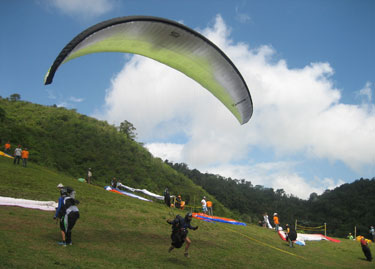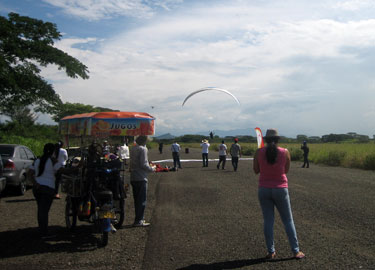Paragliding Pre-worlds concludes successfully in Colombia
The Paragliding Pre-Worlds in Roldanillo, Colombia, came to a successful conclusion last week. Four tasks were flown in 6 days and 147 pilots had the opportunity to try out CIVL’s experimental ‘Final Glide Decelerator’ techniques, the conical end of speed section (CESS) and the arrival altitude time bonus (AATB).
The overall winners on the podium were Julian Andres Carreno Colonia (Ozone Enzo) from Colombia, in first place, American, Gavin McClurg (Niviuk Icepeak 6), in second place and Bernardo Medina Sastre (Enzo), also from Colombia, in third.
Not only were there five Colombians in the top 10, but the top female pilot (22nd overall) was Colombian! Andrea Jaramillo (Icepeak 6) was followed by Isabella Messenger (Icepeak 6) from Germany. Russian, Daria Krasnova (Trango X-Lite 2) was third.
The AATB was used for the first task. A conical ESS was set in the next three tasks. The first attempt at the CESS, unfortunately, was stopped due to rain on the course line before pilots reached goal. On the second, pilots arrived low from the last turnpoint, with a couple dropping short, and one who seemingly managed to fly under the cone to cross the goal line! On the last task, pilots arrived high at a different goal field. Some pilots were clearly struggling to grasp the concepts, especially as instruments are not yet supporting the features. Some were heard to say that it is extremely difficult to change their mindset when they see the goal line from the air! Most were interested and some enthusiastic to see how it would work. The tracklogs from this event will certainly give the scoring software analysts a little more data to study.
Pilots and organisers also had to contend with a competition altitude limit of 2300m (measured using GPS altitude), which had to be introduced following a change to airspace regulations for the area. Unfortunately, this led to a significant number of penalties for infringements in three tasks. The difference between GPS altitude and barometric altitude appeared to be the root cause, as many pilots were looking at barometric altitude on their instruments to keep them under the limit, while their track was being recorded with GPS altitude. The difference could have been up to 100m, depending on the instrument and the pressure of the day.
Louise Joselyn
Photo caption: From left: Gavin McClurg (USA), Julian Carreno (Colombia), Andrea Jaramillo (Colombia) and Bernardo Medina Sastre (Colombia)



